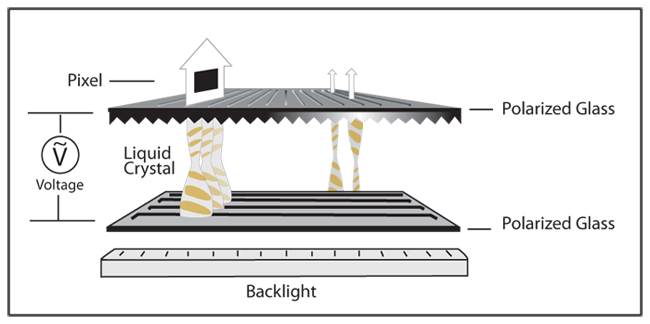LCDs (Liquid Crystal Displays) are monochromatic passive or active matrix displays that can display information as text or in a dot matrix pattern. This type of technology is perfect for less demanding applications since they require less power than VFDs and are typically less expensive than other display technologies.
Newhaven Display offers passive matrix character and graphic display types. The character displays come in standard sizes and can be used as compatible replacements for VFD modules. They feature pre-programmed font tables to display simple text and are available as either STN or FSTN type displays.
Newhaven Display’s Graphic LCDs are available in standard sizes and interfaces. They use a dot matrix pattern to display both text and simple bitmap images. They also come as either STN or FSTN type displays. Newhaven Display offers custom designs for both the character and graphic LCDs.
In order to understand how LCDs work, it is important to know how they are made. To start, LCDs are composed of two pieces of polarized glass. On the non-polarized side of the glass, a special polymer is added to create grooves that run in the same direction as the polarizing film. Once this is done, a liquid crystal material is added to the grooved side of one of the polarized glasses. These grooves align the liquid crystal with the glass. The second piece of glass is placed on top with the grooved side in, aligned perpendicular to the first pieces of glass creating a row and column arrangement.

Dort, wo sich die Rillen der beiden polarisierten Glasstücke überschneiden, befindet sich ein Pixel. Indem das Licht daran gehindert wird, durch das obere Glasstück zu dringen, entsteht ein Bereich, der dunkler ist als die Umgebung. Dadurch entsteht der Eindruck, dass die Pixel ein- oder ausgeschaltet sind. Um das Licht am Durchgang zu hindern, muss die Ausrichtung des Flüssigkristalls geändert werden. Dazu ist eine elektrische Ladung erforderlich. Ohne elektrische Ladung wird der Flüssigkristall verdreht, wodurch sich der Winkel des Lichts so ändert, dass er dem Winkel des oberen polarisierten Glases entspricht. Dadurch wird das Licht durchgelassen. Wenn eine elektrische Ladung angelegt wird, dreht sich der Flüssigkristall wieder auf, wobei der Winkel des Lichts unverändert bleibt. Dies führt dazu, dass das Licht durch das obere senkrechte Stück des polarisierten Glases blockiert wird (siehe obiges animiertes Bild als Beispiel). Die Entscheidung, welche Pixel ein- und ausgeschaltet werden, wird von den Steuerungen auf dem Bildschirm getroffen. Diese Steuerungen sind so programmiert, dass sie Benutzerdaten in vordefinierte Schriftarten übersetzen oder die entsprechend adressierten Pixel einschalten.
LCDs come in various display modes, the two that are most commonly used are STNs and FSTNs. STN (super-twisted neumatic) displays provide more contrast than TN (twisted neumatic) displays by twisting the crystal molecules from 180 to 270 degrees. FSTN (filtered super-twisted neumatic) displays use a film compensating layer between the STN display and the rear polarizer. This ads sharpness and better contrast to the display.
